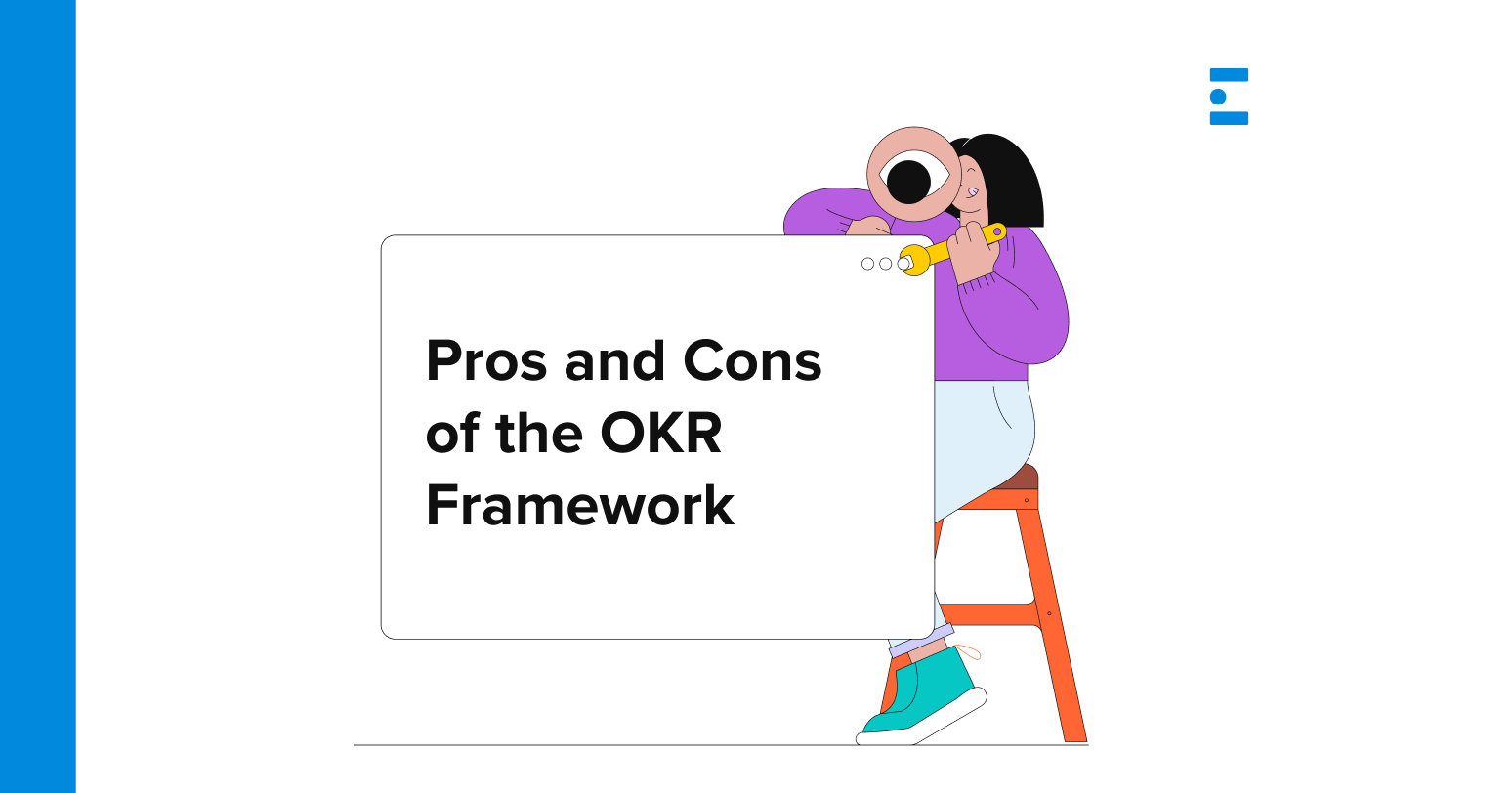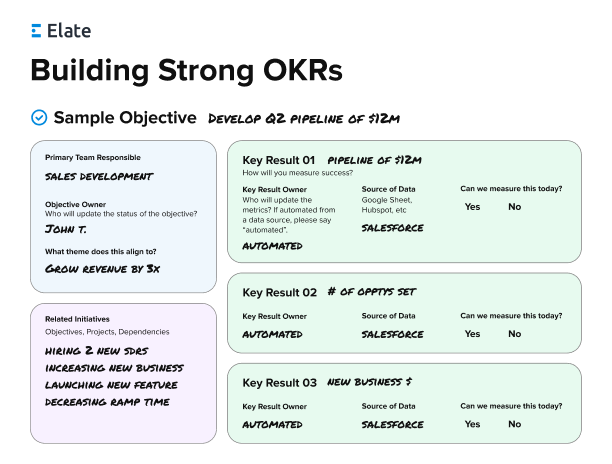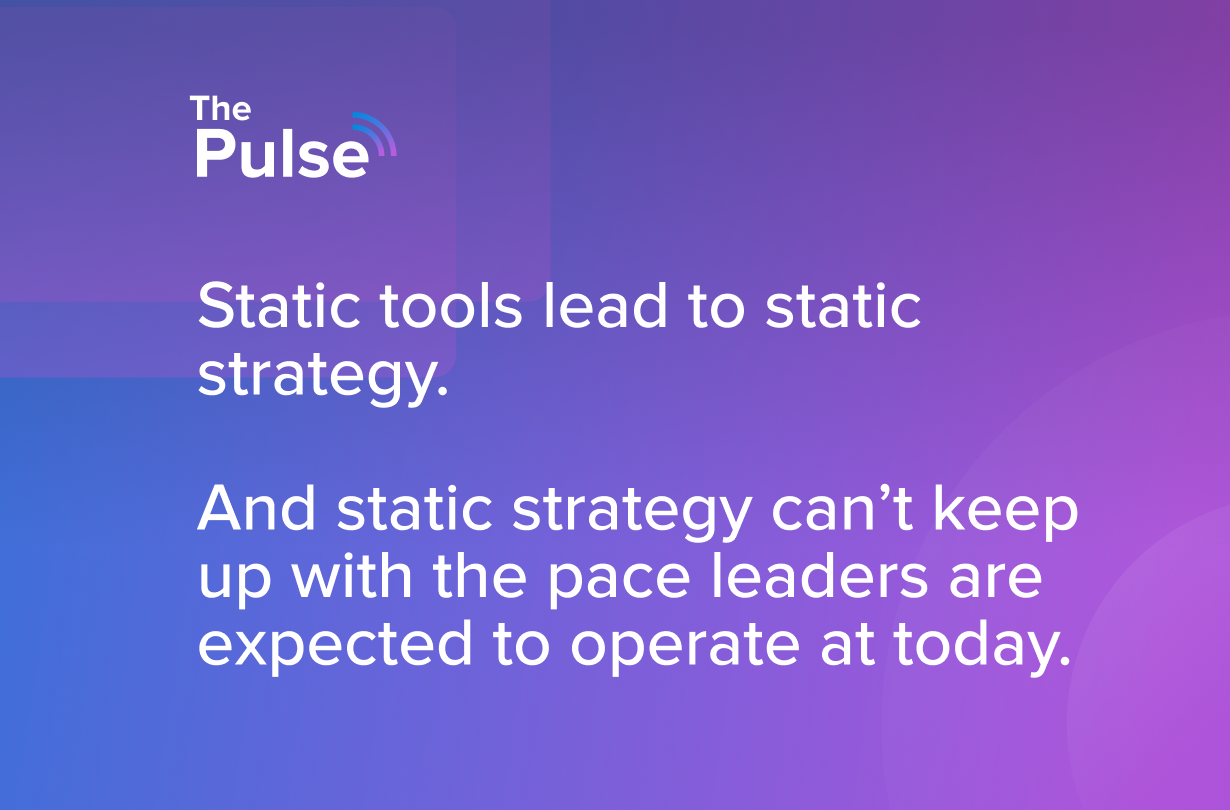
The OKRs framework has gained popularity in recent years as a tool for goal setting and performance management. It's a system that helps organizations and teams set objectives and key results (hence the name!) to track progress and drive alignment on where the company is going. Like other strategic planning frameworks, OKRs come with their own set of advantages and disadvantages.
In this article, we will explore the pros and cons of the OKRs framework and discuss how it can be implemented effectively. Let's get started!
Understanding the OKRs Framework
Before diving into the pros and cons, let's first understand what the OKRs framework is all about.
OKRs, which stands for Objectives and Key Results (whoa!), is a goal-setting methodology developed by Intel's Andrew Grove in the 1970s and was later popularized by John Doerr during his time at Google. Simply put, OKRs are a way to set ambitious goals (or objectives) and define measurable outcomes (key results) that will indicate progress towards those goals.
When it comes to goal setting, the OKRs framework provides a clear structure that can be beneficial for individuals, teams, and organizations. By using this framework, individuals and teams can align their efforts and focus on what truly matters. It helps create a sense of purpose and direction, ensuring that everyone is working towards the same objectives.
Depending on your team or company, OKRs can look differently across the board. So we've put together some examples:
- OKR examples for customer success teams
- Product team OKRs
- Startup company OKR dos and don'ts
- OKRs for software developers
What is the OKRs Framework?
The OKR framework provides a clear structure for goal setting and tracking progress. Objectives are qualitative statements that define what needs to be achieved. They should be ambitious, inspiring, and aligned with the organization's vision. Objectives serve as a guiding light, giving individuals and teams a sense of purpose and direction.
Key Results, on the other hand, are specific and measurable outcomes that indicate progress towards the objectives. They should be time-bound and quantifiable, providing a clear way to determine success or failure. Key Results are the measurable milestones that help individuals and teams track their progress and stay accountable.
By having both objectives and key results, the OKRs framework ensures that goals are not just vague aspirations (like KPIs) but are backed by tangible metrics. This helps in keeping individuals and teams focused, motivated, and aligned.
Related Reading: Settling the Debate Between OKR vs KPI
The Origin of the OKRs Framework
The OKR framework has its roots in the management philosophy of Peter Drucker, who introduced the concept of Management by Objectives (MBO) in his book "The Practice of Management" in 1954. Drucker believed that setting clear objectives and measuring outcomes could drive performance and improve organizational effectiveness.
Andrew Grove, while at Intel, took MBO a step further and refined the concept into what we now know as OKR. Grove recognized the need for a goal-setting framework that could adapt to the fast-paced and ever-changing business environment. He believed that by setting objectives and measuring outcomes, organizations could foster a culture of accountability and continuous improvement. How smart!
Over time, the OKR framework gained popularity, especially in the tech industry. John Doerr, a venture capitalist who worked closely with Grove at Intel, played a significant role in popularizing OKRs at Google. He introduced the framework to Google's leadership team, and it quickly became an integral part of the company's culture.
Today, the OKR framework is widely used by organizations of all sizes and industries. It has proven to be an effective goal-setting methodology that promotes alignment, transparency, and accountability. By setting ambitious objectives and defining measurable key results, organizations can drive performance, foster innovation, and achieve their desired outcomes.

The Advantages of the OKRs Framework
Now that we understand the basics of the OKR framework, let's explore the advantages it offers to organizations and teams.
OKRs Promote Clear Communication
One of the biggest advantages of the OKR framework is its ability to promote clear communication within an organization. By aligning objectives and key results, team members can better understand what needs to be achieved and how their efforts contribute to the overall goals. This clarity helps eliminate ambiguity while ensuring everyone is working towards the same vision.
Clear communication is essential for the success of any organization, so naturally, when team members have a clear understanding of the objectives and key results, they can collaborate more effectively and make informed decisions. With the OKR framework, organizations can establish a common language and a shared understanding of what needs to be accomplished.
Moreover, the OKRs framework encourages regular check-ins and progress updates, further enhancing communication within teams. By discussing the progress of objectives and key results, team members can provide feedback, share insights, and address any challenges or roadblocks that may arise. This open and transparent communication fosters a culture of collaboration and continuous improvement.
OKRs Encourage Accountability and Transparency
The OKRs framework encourages a culture of accountability and transparency, especially at the leadership level. By setting ambitious objectives and defining specific key results, individuals and teams are held accountable for their performance. The transparency of the OKRs also allows for visibility into the progress of different teams and departments, fostering a sense of ownership and collective responsibility.
Accountability is crucial for driving results and ensuring that everyone is focused on achieving the desired outcomes. With the OKRs framework, individuals and teams are responsible for their own objectives and key results, which creates a sense of ownership and motivates them to perform at their best. The transparency of the OKRs also enables leaders and managers to track progress, identify areas for improvement, and provide support or guidance when needed.
Furthermore, the OKRs framework promotes transparency by making objectives and key results visible to everyone in the organization. This transparency allows individuals and teams to understand how their work aligns with the broader goals of the organization and how their contributions impact the overall success. It also encourages collaboration and knowledge sharing, as teams can learn from each other's progress and achievements.
OKRs Facilitate Alignment and Collaboration
OKRs help create alignment and collaboration across different teams and departments. When objectives and key results are shared openly, individuals and teams can see how their work connects to broader organizational goals. At Elate we call this connecting long-term strategy with tactical execution. This alignment encourages collaboration, as teams can identify opportunities for synergy and work together towards shared objectives.
Alignment is essential for organizations to achieve their strategic objectives. With the OKRs framework, organizations can ensure that every team and individual is aligned with the overall mission, vision, values (MVV). By cascading objectives from the top down, organizations can create a clear line of sight from the highest-level goals to individual tasks and responsibilities.
Collaboration is also fostered through the OKRs framework. When teams have visibility into each other's objectives and key results, they can identify areas of overlap or dependencies. This enables them to coordinate efforts, share resources, and leverage each other's expertise to achieve better outcomes. By working together towards shared objectives, teams can achieve more than they could individually.
The OKRs framework offers several advantages to organizations and teams. It promotes clear communication, encourages accountability and transparency, and facilitates alignment and collaboration. By implementing the OKRs framework, organizations can enhance their performance, drive results, and achieve their strategic objectives.

The Disadvantages of the OKRs Framework
While the OKRs framework brings numerous benefits, it also has its share of disadvantages that organizations must be aware of.
Implementing the OKRs framework can be a complex process that requires careful consideration and planning. It is important to understand the potential downsides to ensure a successful implementation and maximize the benefits.
OKRs Can Lead to an Overemphasis of Numerical Goals
One of the potential downsides of the OKRs framework is the overemphasis on quantitative goals. Since key results are often measurable outcomes, there can be a tendency to focus solely on achieving numerical targets.
While it is important to have measurable goals, this narrow focus may lead to a neglect of qualitative aspects or long-term strategic goals. Organizations must strike a balance between quantitative and qualitative objectives to ensure overall organizational health and growth.
For example, a company may set a key result to increase revenue by 20% within a quarter. While this is a measurable goal, it is equally important to consider the customer experience, employee satisfaction, and long-term sustainability in achieving this target.
There's Potential for Misalignment of Objectives
If not implemented correctly, the OKRs framework can lead to misalignment of objectives. Objectives set by one team may not align with the goals of another, resulting in conflicting priorities and wasted efforts.
Clear communication and coordination are crucial when implementing OKRs across the organization. Regular meetings and discussions should be held to ensure that objectives are aligned and everyone is working towards a common goal.
For instance, if the marketing team sets a key result to increase website traffic by 50%, but the sales team focuses on closing deals without considering the quality of leads generated, it can lead to a misalignment of efforts and hinder overall organizational success.
The Risk of Overcomplication... and Misinterpretation
The OKRs framework, when overly complicated or misinterpreted, can become a burden rather than a tool for improvement. If the process becomes "too" structured or the language used in setting objectives and key results is unclear, the entire system can lose its effectiveness.
Simplicity is key when implementing OKRs. The framework should be user-friendly and easy to understand for all employees. Clear guidelines (and training if needed) should be provided to ensure that everyone understands how to set effective objectives and key results.
For example, if the OKRs process becomes overly "bureaucratic" with excessive approval processes, it can demotivate employees and hinder their ability to focus on achieving results.
While the OKRs framework has its disadvantages, organizations can mitigate these risks by implementing it thoughtfully and with clear communication. By striking a balance between quantitative and qualitative goals, ensuring alignment of objectives, and keeping the process simple and user-friendly, organizations can leverage the OKRs framework to drive growth and success.
3 Steps on Writing Objectives Using the OKR Framework
Before jumping into best practices on implementing the OKR framework, let's look at one of the most important aspects: writing objectives. This is so important that we built an entire worksheet on how to build objectives properly!
Step 1: Create Strong Objectives with Concise Names
Keep it clear and simple. We suggest the verb + noun formula!

Step 2: Write Key Results that are Outcomes and Not Outputs
Remember - you must define how success will be measured!

Step 3: Define Relationships on your Objectives to Connect the Dots
The final step is to define relationships to show how your objective supports the high-level strategy.

Implementing the OKR Framework
So now that we've explored both the advantages and disadvantages of the OKR framework, let's discuss how you can implement it effectively. We have a full "do's and don'ts" list compiled for startups implementing OKRs!
6 Steps to Implement OKRs in Your Organization
Ready to roll out the framework? Here are six steps when planning and setting OKRs:
- Educate and train employees on the OKRs framework to ensure everyone understands its purpose and benefits.
- Clearly define strategic objectives that align with the organization's vision and communicate them to all teams and individuals.
- Encourage collaborative goal setting by involving employees in the process and seeking their input.
- Ensure that key results are specific, measurable, attainable, relevant, and time-bound (SMART).
- Regularly track and review progress against OKRs, providing feedback and support where needed.
- Foster a culture of continuous improvement by learning from successes and failures and adjusting objectives accordingly.
5 Common Mistakes to Avoid When Implementing OKRs
On the flip side, here are a few things to avoid when implementing OKRs:
- Setting too many objectives and key results, which can lead to a lack of focus and diluted efforts.
- Focusing solely on achieving the numbers without considering the broader impact and strategic goals.
- Neglecting ongoing communication and dialogue about OKRs, which can lead to misalignment and confusion.
- Failure to adapt and adjust OKRs when circumstances change or new information becomes available.
- Ignoring the importance of celebrating successes and recognizing achievements along the way to keep teams motivated.
Similarly, there are many overlooked best practices when implementing OKRs.
A Case Study of OKRs in Action
Let's look at a real-life example of an organization that successfully implemented the OKRs framework.
How Seismic Made OKRs a Part of Company Culture
Seismic, a global leader in enablement, training, and coaching solutions that enable sales and marketing teams to engage buyers and grow revenue, had tried other OKR solutions in the past, but they struggled to get the other solutions to stick. They lacked consistent adoption from the whole company, and needed to reimagine a new ideal process for setting and managing goals.
After these missteps in rolling out OKRs, missing on a solution to drive transparency and bring their strategy to life was a non-negotiable. Seismic needed a solution that intuitively aligned team members and enabled adoption from day one and they partnered with Elate!
Since implementing Elate, Seismic has increased transparency, streamlined updates, and created a unified view of objectives and results. Read all about Seismic's success implementing OKRs with Elate.

In conclusion
The OKRs framework can be a powerful tool for organizations looking to set clear goals, drive alignment, and track performance. However, it is important to weigh the pros and cons before implementing the framework to ensure it aligns with the organization's culture and objectives. By understanding the advantages and disadvantages, and following best practices for implementation, organizations can make the most of the OKRs framework and leverage its potential to achieve success.
There are many OKR software providers, including Elate! If you want to implement OKRs, get in touch with our team to learn how we can help.
Related OKR Framework Resources:
We have an entire OKR section on our blog!


